Program Planning and Evaluation in Public Health: A Detailed Report
VerifiedAdded on 2020/03/16
|8
|1905
|43
Report
AI Summary
This report, titled "Program Planning and Evaluation in Public Health," examines the critical role of patient experience measurement in assessing and improving healthcare quality. It emphasizes the importance of patient-centered care and explores various aspects of patient experience, including communication, responsiveness of staff, and ease of access to information. The report outlines methods for measuring patient experience, such as questionnaires and interviews, and highlights the use of mixed methods incorporating both qualitative and quantitative approaches. It further discusses the study's methodology, including the target population (patients in hospitals and those who have previously encountered care), and the use of the Pearson's Chi-square test to assess the significance of patient satisfaction. The report also analyzes data on patient satisfaction with gynecologists and obstetricians compared to other specialists, highlighting the importance of factors such as minimizing waiting times and enhancing communication. Ethical considerations, such as language barriers, are also addressed. Ultimately, the report underscores the close link between patient satisfaction and interpersonal processes of care, advocating for patient-centered decision-making and improved communication within healthcare settings.
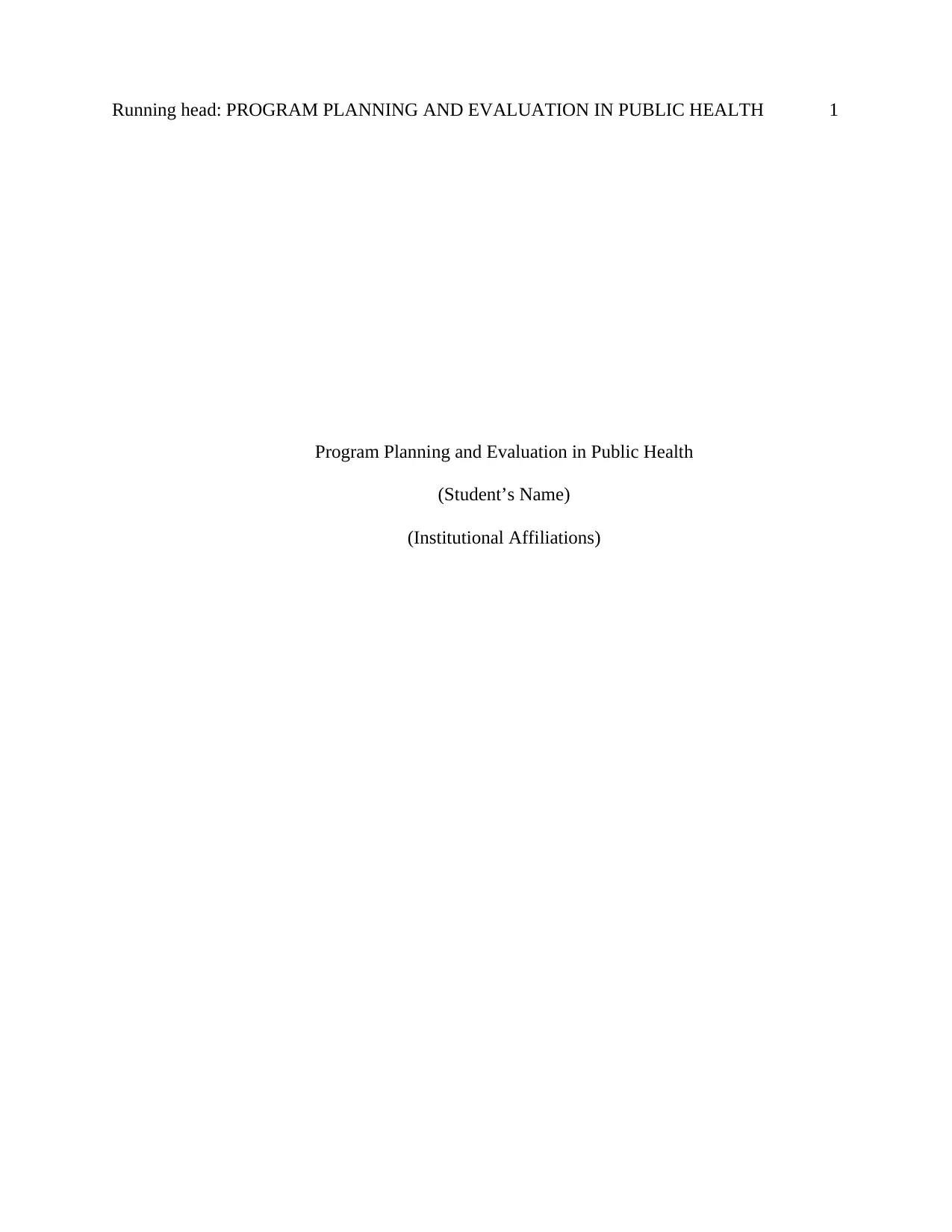
Running head: PROGRAM PLANNING AND EVALUATION IN PUBLIC HEALTH 1
Program Planning and Evaluation in Public Health
(Student’s Name)
(Institutional Affiliations)
Program Planning and Evaluation in Public Health
(Student’s Name)
(Institutional Affiliations)
Paraphrase This Document
Need a fresh take? Get an instant paraphrase of this document with our AI Paraphraser
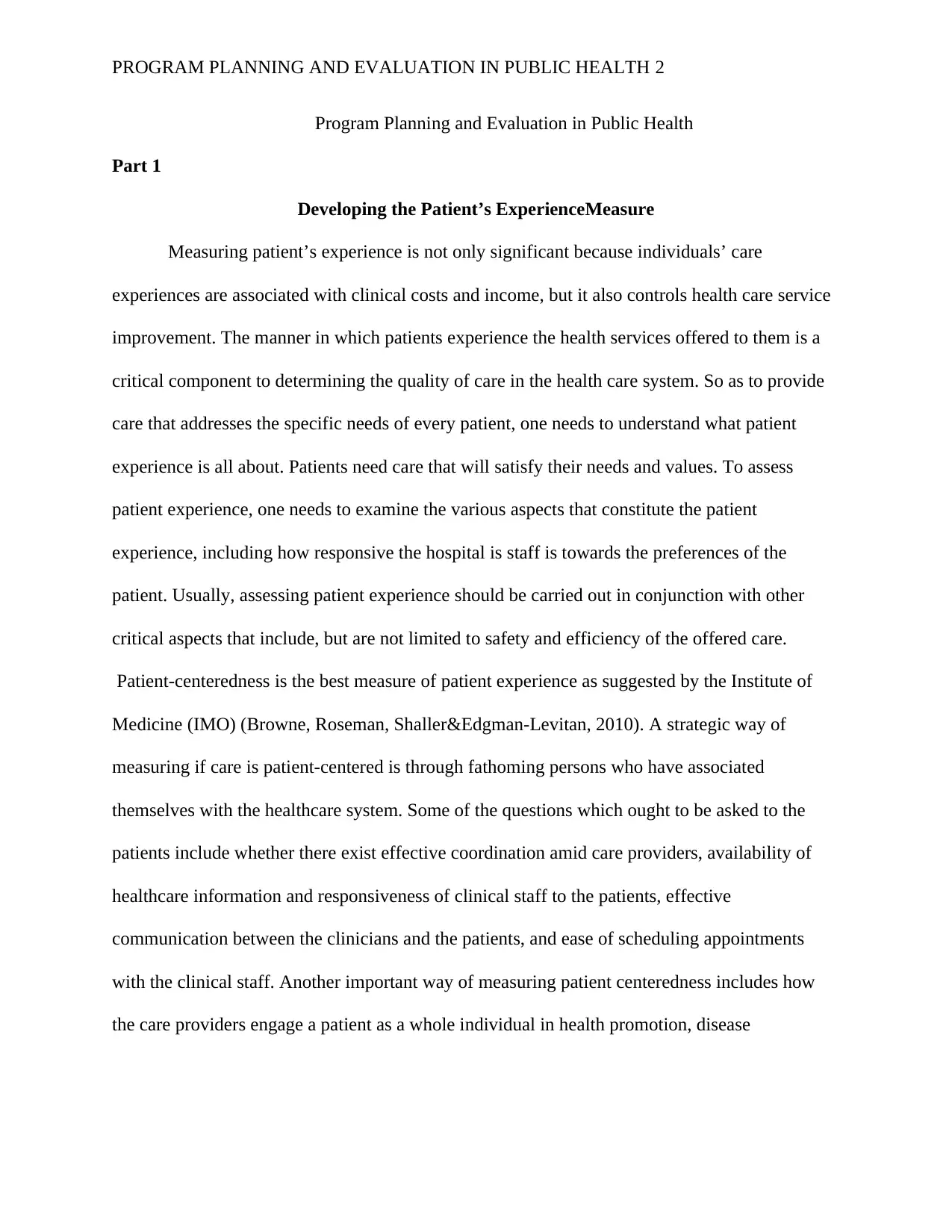
PROGRAM PLANNING AND EVALUATION IN PUBLIC HEALTH 2
Program Planning and Evaluation in Public Health
Part 1
Developing the Patient’s ExperienceMeasure
Measuring patient’s experience is not only significant because individuals’ care
experiences are associated with clinical costs and income, but it also controls health care service
improvement. The manner in which patients experience the health services offered to them is a
critical component to determining the quality of care in the health care system. So as to provide
care that addresses the specific needs of every patient, one needs to understand what patient
experience is all about. Patients need care that will satisfy their needs and values. To assess
patient experience, one needs to examine the various aspects that constitute the patient
experience, including how responsive the hospital is staff is towards the preferences of the
patient. Usually, assessing patient experience should be carried out in conjunction with other
critical aspects that include, but are not limited to safety and efficiency of the offered care.
Patient-centeredness is the best measure of patient experience as suggested by the Institute of
Medicine (IMO) (Browne, Roseman, Shaller&Edgman-Levitan, 2010). A strategic way of
measuring if care is patient-centered is through fathoming persons who have associated
themselves with the healthcare system. Some of the questions which ought to be asked to the
patients include whether there exist effective coordination amid care providers, availability of
healthcare information and responsiveness of clinical staff to the patients, effective
communication between the clinicians and the patients, and ease of scheduling appointments
with the clinical staff. Another important way of measuring patient centeredness includes how
the care providers engage a patient as a whole individual in health promotion, disease
Program Planning and Evaluation in Public Health
Part 1
Developing the Patient’s ExperienceMeasure
Measuring patient’s experience is not only significant because individuals’ care
experiences are associated with clinical costs and income, but it also controls health care service
improvement. The manner in which patients experience the health services offered to them is a
critical component to determining the quality of care in the health care system. So as to provide
care that addresses the specific needs of every patient, one needs to understand what patient
experience is all about. Patients need care that will satisfy their needs and values. To assess
patient experience, one needs to examine the various aspects that constitute the patient
experience, including how responsive the hospital is staff is towards the preferences of the
patient. Usually, assessing patient experience should be carried out in conjunction with other
critical aspects that include, but are not limited to safety and efficiency of the offered care.
Patient-centeredness is the best measure of patient experience as suggested by the Institute of
Medicine (IMO) (Browne, Roseman, Shaller&Edgman-Levitan, 2010). A strategic way of
measuring if care is patient-centered is through fathoming persons who have associated
themselves with the healthcare system. Some of the questions which ought to be asked to the
patients include whether there exist effective coordination amid care providers, availability of
healthcare information and responsiveness of clinical staff to the patients, effective
communication between the clinicians and the patients, and ease of scheduling appointments
with the clinical staff. Another important way of measuring patient centeredness includes how
the care providers engage a patient as a whole individual in health promotion, disease
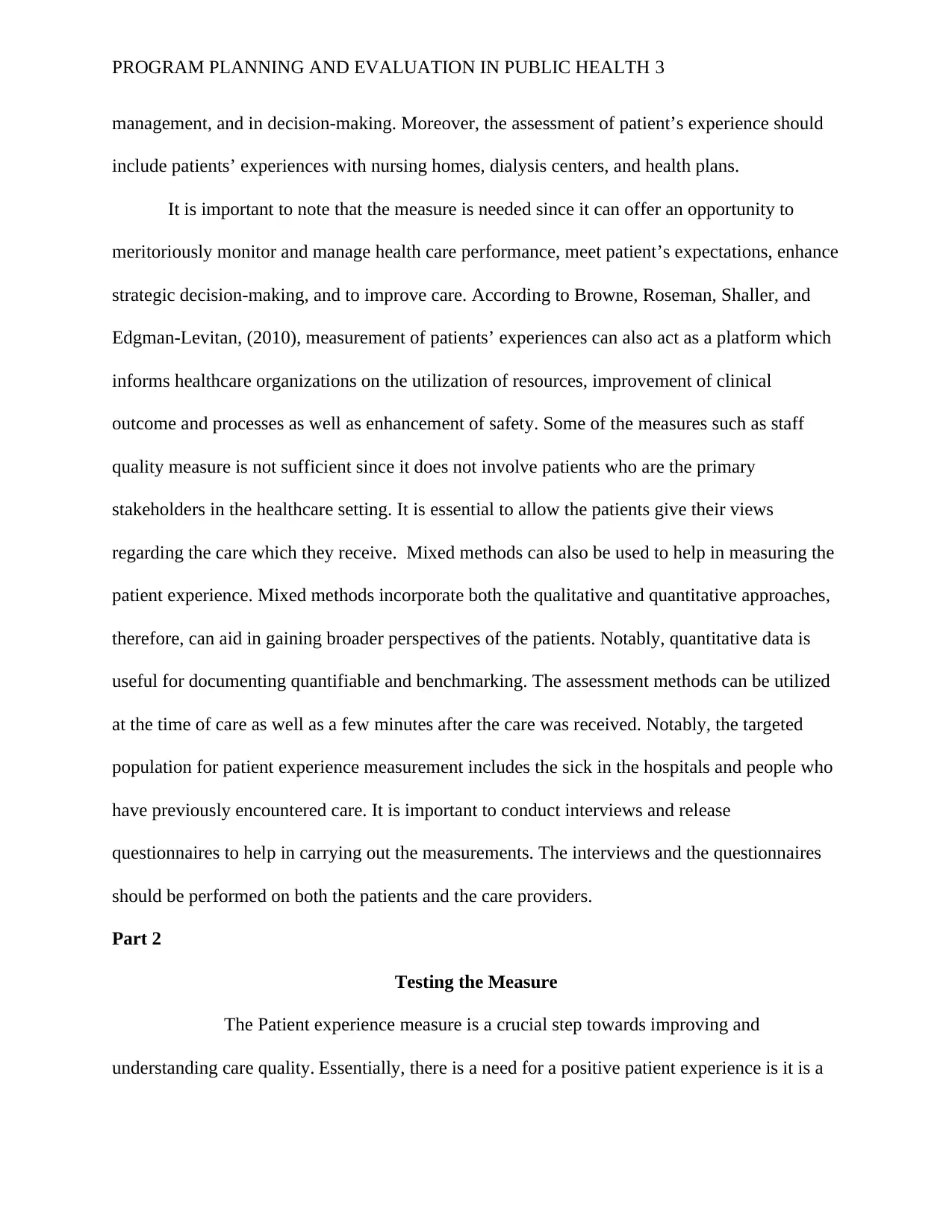
PROGRAM PLANNING AND EVALUATION IN PUBLIC HEALTH 3
management, and in decision-making. Moreover, the assessment of patient’s experience should
include patients’ experiences with nursing homes, dialysis centers, and health plans.
It is important to note that the measure is needed since it can offer an opportunity to
meritoriously monitor and manage health care performance, meet patient’s expectations, enhance
strategic decision-making, and to improve care. According to Browne, Roseman, Shaller, and
Edgman-Levitan, (2010), measurement of patients’ experiences can also act as a platform which
informs healthcare organizations on the utilization of resources, improvement of clinical
outcome and processes as well as enhancement of safety. Some of the measures such as staff
quality measure is not sufficient since it does not involve patients who are the primary
stakeholders in the healthcare setting. It is essential to allow the patients give their views
regarding the care which they receive. Mixed methods can also be used to help in measuring the
patient experience. Mixed methods incorporate both the qualitative and quantitative approaches,
therefore, can aid in gaining broader perspectives of the patients. Notably, quantitative data is
useful for documenting quantifiable and benchmarking. The assessment methods can be utilized
at the time of care as well as a few minutes after the care was received. Notably, the targeted
population for patient experience measurement includes the sick in the hospitals and people who
have previously encountered care. It is important to conduct interviews and release
questionnaires to help in carrying out the measurements. The interviews and the questionnaires
should be performed on both the patients and the care providers.
Part 2
Testing the Measure
The Patient experience measure is a crucial step towards improving and
understanding care quality. Essentially, there is a need for a positive patient experience is it is a
management, and in decision-making. Moreover, the assessment of patient’s experience should
include patients’ experiences with nursing homes, dialysis centers, and health plans.
It is important to note that the measure is needed since it can offer an opportunity to
meritoriously monitor and manage health care performance, meet patient’s expectations, enhance
strategic decision-making, and to improve care. According to Browne, Roseman, Shaller, and
Edgman-Levitan, (2010), measurement of patients’ experiences can also act as a platform which
informs healthcare organizations on the utilization of resources, improvement of clinical
outcome and processes as well as enhancement of safety. Some of the measures such as staff
quality measure is not sufficient since it does not involve patients who are the primary
stakeholders in the healthcare setting. It is essential to allow the patients give their views
regarding the care which they receive. Mixed methods can also be used to help in measuring the
patient experience. Mixed methods incorporate both the qualitative and quantitative approaches,
therefore, can aid in gaining broader perspectives of the patients. Notably, quantitative data is
useful for documenting quantifiable and benchmarking. The assessment methods can be utilized
at the time of care as well as a few minutes after the care was received. Notably, the targeted
population for patient experience measurement includes the sick in the hospitals and people who
have previously encountered care. It is important to conduct interviews and release
questionnaires to help in carrying out the measurements. The interviews and the questionnaires
should be performed on both the patients and the care providers.
Part 2
Testing the Measure
The Patient experience measure is a crucial step towards improving and
understanding care quality. Essentially, there is a need for a positive patient experience is it is a
⊘ This is a preview!⊘
Do you want full access?
Subscribe today to unlock all pages.

Trusted by 1+ million students worldwide
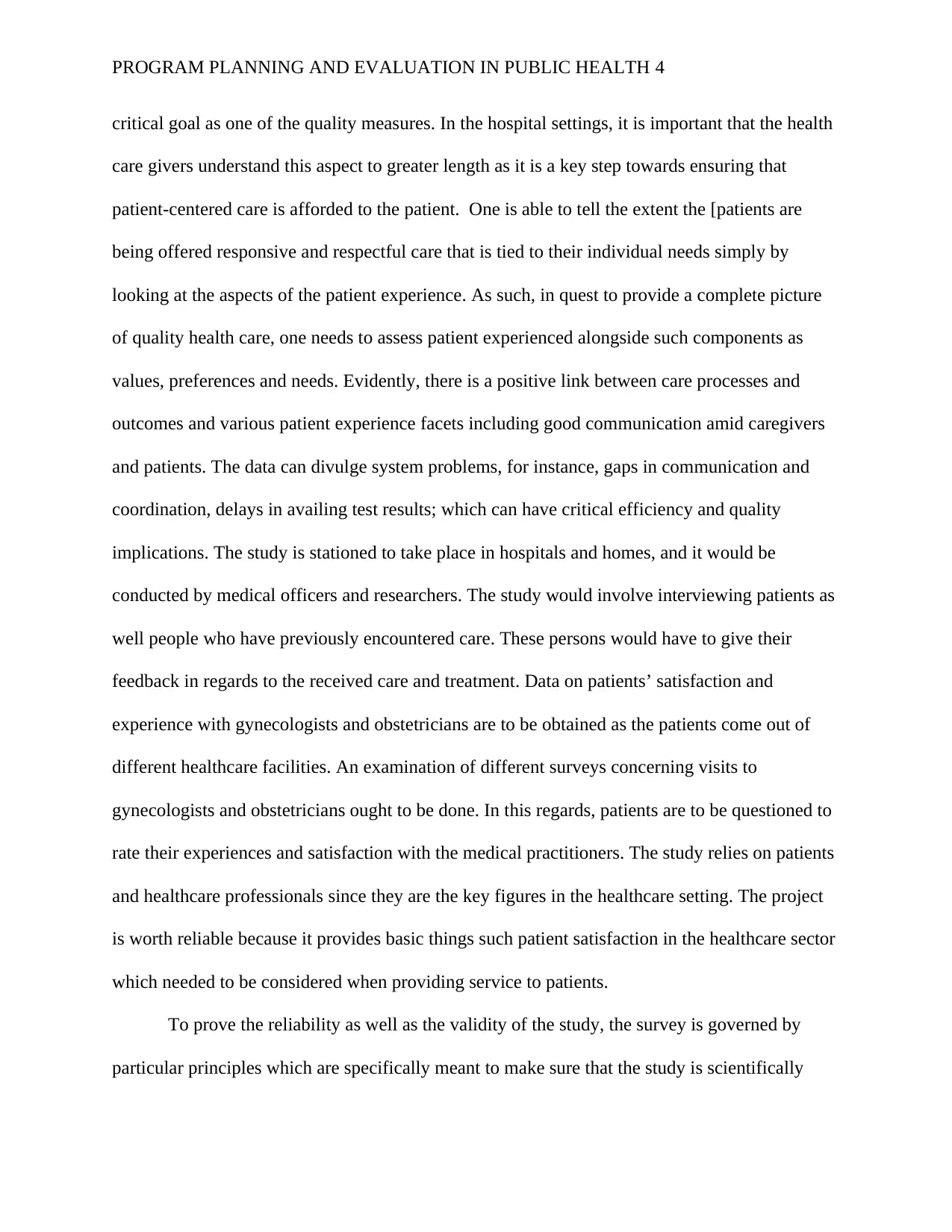
PROGRAM PLANNING AND EVALUATION IN PUBLIC HEALTH 4
critical goal as one of the quality measures. In the hospital settings, it is important that the health
care givers understand this aspect to greater length as it is a key step towards ensuring that
patient-centered care is afforded to the patient. One is able to tell the extent the [patients are
being offered responsive and respectful care that is tied to their individual needs simply by
looking at the aspects of the patient experience. As such, in quest to provide a complete picture
of quality health care, one needs to assess patient experienced alongside such components as
values, preferences and needs. Evidently, there is a positive link between care processes and
outcomes and various patient experience facets including good communication amid caregivers
and patients. The data can divulge system problems, for instance, gaps in communication and
coordination, delays in availing test results; which can have critical efficiency and quality
implications. The study is stationed to take place in hospitals and homes, and it would be
conducted by medical officers and researchers. The study would involve interviewing patients as
well people who have previously encountered care. These persons would have to give their
feedback in regards to the received care and treatment. Data on patients’ satisfaction and
experience with gynecologists and obstetricians are to be obtained as the patients come out of
different healthcare facilities. An examination of different surveys concerning visits to
gynecologists and obstetricians ought to be done. In this regards, patients are to be questioned to
rate their experiences and satisfaction with the medical practitioners. The study relies on patients
and healthcare professionals since they are the key figures in the healthcare setting. The project
is worth reliable because it provides basic things such patient satisfaction in the healthcare sector
which needed to be considered when providing service to patients.
To prove the reliability as well as the validity of the study, the survey is governed by
particular principles which are specifically meant to make sure that the study is scientifically
critical goal as one of the quality measures. In the hospital settings, it is important that the health
care givers understand this aspect to greater length as it is a key step towards ensuring that
patient-centered care is afforded to the patient. One is able to tell the extent the [patients are
being offered responsive and respectful care that is tied to their individual needs simply by
looking at the aspects of the patient experience. As such, in quest to provide a complete picture
of quality health care, one needs to assess patient experienced alongside such components as
values, preferences and needs. Evidently, there is a positive link between care processes and
outcomes and various patient experience facets including good communication amid caregivers
and patients. The data can divulge system problems, for instance, gaps in communication and
coordination, delays in availing test results; which can have critical efficiency and quality
implications. The study is stationed to take place in hospitals and homes, and it would be
conducted by medical officers and researchers. The study would involve interviewing patients as
well people who have previously encountered care. These persons would have to give their
feedback in regards to the received care and treatment. Data on patients’ satisfaction and
experience with gynecologists and obstetricians are to be obtained as the patients come out of
different healthcare facilities. An examination of different surveys concerning visits to
gynecologists and obstetricians ought to be done. In this regards, patients are to be questioned to
rate their experiences and satisfaction with the medical practitioners. The study relies on patients
and healthcare professionals since they are the key figures in the healthcare setting. The project
is worth reliable because it provides basic things such patient satisfaction in the healthcare sector
which needed to be considered when providing service to patients.
To prove the reliability as well as the validity of the study, the survey is governed by
particular principles which are specifically meant to make sure that the study is scientifically
Paraphrase This Document
Need a fresh take? Get an instant paraphrase of this document with our AI Paraphraser
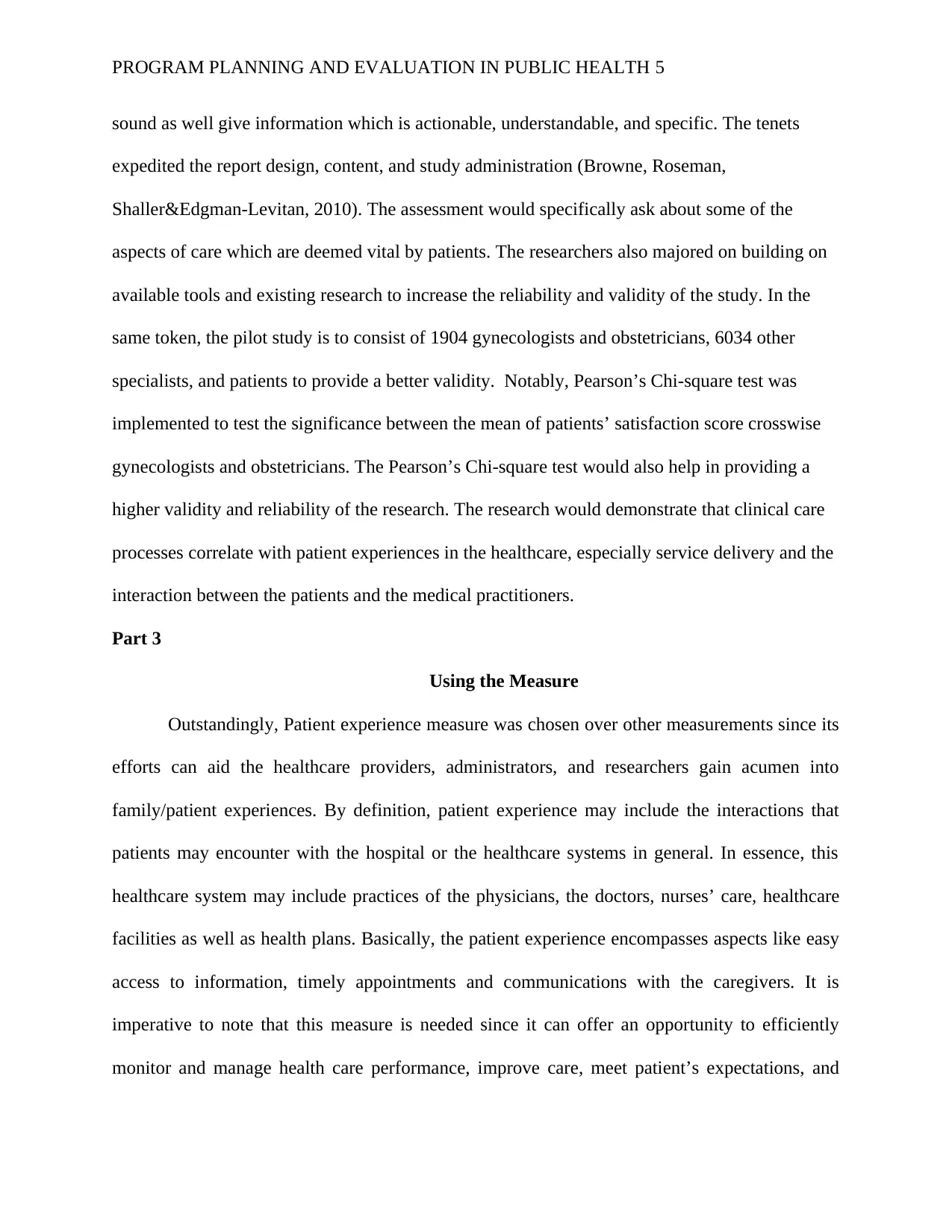
PROGRAM PLANNING AND EVALUATION IN PUBLIC HEALTH 5
sound as well give information which is actionable, understandable, and specific. The tenets
expedited the report design, content, and study administration (Browne, Roseman,
Shaller&Edgman-Levitan, 2010). The assessment would specifically ask about some of the
aspects of care which are deemed vital by patients. The researchers also majored on building on
available tools and existing research to increase the reliability and validity of the study. In the
same token, the pilot study is to consist of 1904 gynecologists and obstetricians, 6034 other
specialists, and patients to provide a better validity. Notably, Pearson’s Chi-square test was
implemented to test the significance between the mean of patients’ satisfaction score crosswise
gynecologists and obstetricians. The Pearson’s Chi-square test would also help in providing a
higher validity and reliability of the research. The research would demonstrate that clinical care
processes correlate with patient experiences in the healthcare, especially service delivery and the
interaction between the patients and the medical practitioners.
Part 3
Using the Measure
Outstandingly, Patient experience measure was chosen over other measurements since its
efforts can aid the healthcare providers, administrators, and researchers gain acumen into
family/patient experiences. By definition, patient experience may include the interactions that
patients may encounter with the hospital or the healthcare systems in general. In essence, this
healthcare system may include practices of the physicians, the doctors, nurses’ care, healthcare
facilities as well as health plans. Basically, the patient experience encompasses aspects like easy
access to information, timely appointments and communications with the caregivers. It is
imperative to note that this measure is needed since it can offer an opportunity to efficiently
monitor and manage health care performance, improve care, meet patient’s expectations, and
sound as well give information which is actionable, understandable, and specific. The tenets
expedited the report design, content, and study administration (Browne, Roseman,
Shaller&Edgman-Levitan, 2010). The assessment would specifically ask about some of the
aspects of care which are deemed vital by patients. The researchers also majored on building on
available tools and existing research to increase the reliability and validity of the study. In the
same token, the pilot study is to consist of 1904 gynecologists and obstetricians, 6034 other
specialists, and patients to provide a better validity. Notably, Pearson’s Chi-square test was
implemented to test the significance between the mean of patients’ satisfaction score crosswise
gynecologists and obstetricians. The Pearson’s Chi-square test would also help in providing a
higher validity and reliability of the research. The research would demonstrate that clinical care
processes correlate with patient experiences in the healthcare, especially service delivery and the
interaction between the patients and the medical practitioners.
Part 3
Using the Measure
Outstandingly, Patient experience measure was chosen over other measurements since its
efforts can aid the healthcare providers, administrators, and researchers gain acumen into
family/patient experiences. By definition, patient experience may include the interactions that
patients may encounter with the hospital or the healthcare systems in general. In essence, this
healthcare system may include practices of the physicians, the doctors, nurses’ care, healthcare
facilities as well as health plans. Basically, the patient experience encompasses aspects like easy
access to information, timely appointments and communications with the caregivers. It is
imperative to note that this measure is needed since it can offer an opportunity to efficiently
monitor and manage health care performance, improve care, meet patient’s expectations, and
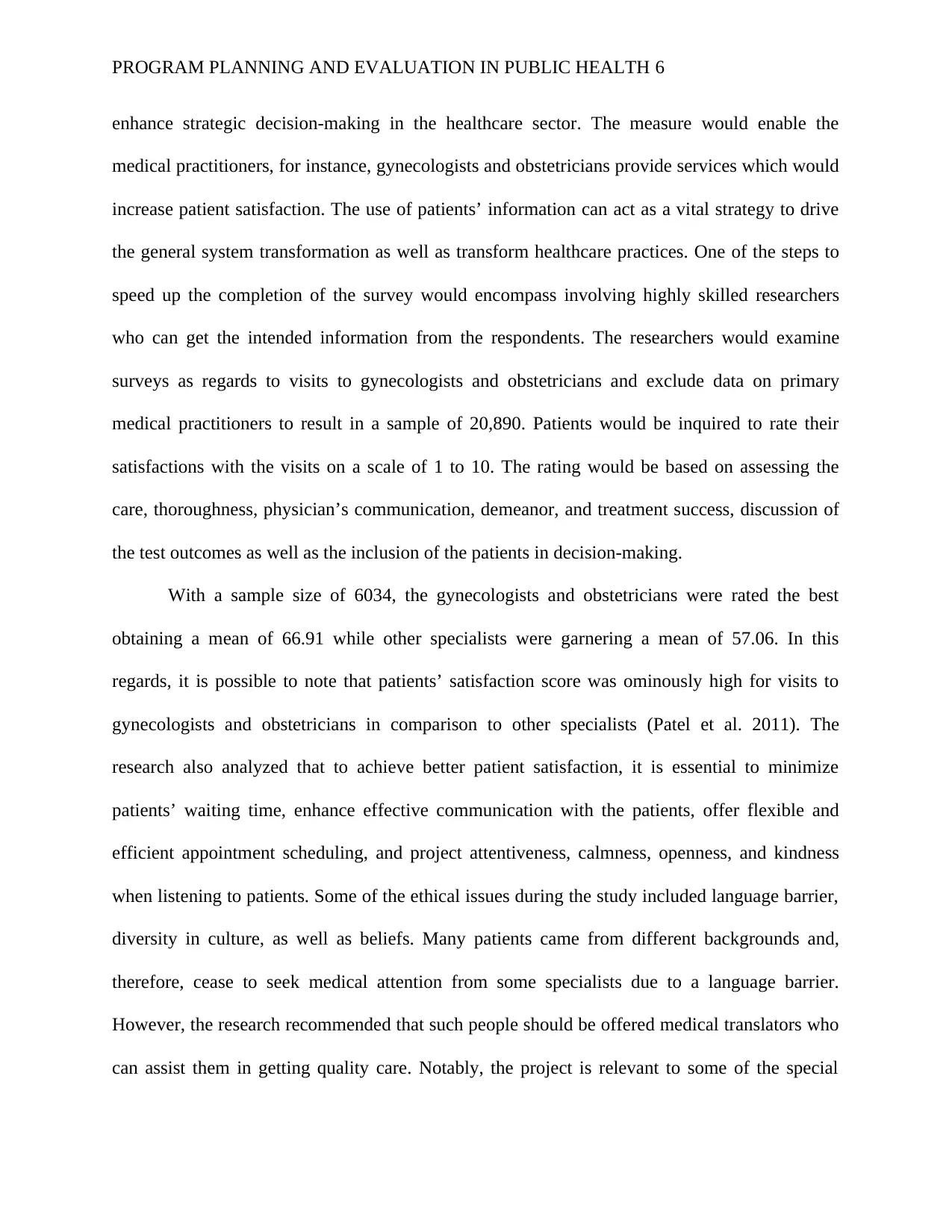
PROGRAM PLANNING AND EVALUATION IN PUBLIC HEALTH 6
enhance strategic decision-making in the healthcare sector. The measure would enable the
medical practitioners, for instance, gynecologists and obstetricians provide services which would
increase patient satisfaction. The use of patients’ information can act as a vital strategy to drive
the general system transformation as well as transform healthcare practices. One of the steps to
speed up the completion of the survey would encompass involving highly skilled researchers
who can get the intended information from the respondents. The researchers would examine
surveys as regards to visits to gynecologists and obstetricians and exclude data on primary
medical practitioners to result in a sample of 20,890. Patients would be inquired to rate their
satisfactions with the visits on a scale of 1 to 10. The rating would be based on assessing the
care, thoroughness, physician’s communication, demeanor, and treatment success, discussion of
the test outcomes as well as the inclusion of the patients in decision-making.
With a sample size of 6034, the gynecologists and obstetricians were rated the best
obtaining a mean of 66.91 while other specialists were garnering a mean of 57.06. In this
regards, it is possible to note that patients’ satisfaction score was ominously high for visits to
gynecologists and obstetricians in comparison to other specialists (Patel et al. 2011). The
research also analyzed that to achieve better patient satisfaction, it is essential to minimize
patients’ waiting time, enhance effective communication with the patients, offer flexible and
efficient appointment scheduling, and project attentiveness, calmness, openness, and kindness
when listening to patients. Some of the ethical issues during the study included language barrier,
diversity in culture, as well as beliefs. Many patients came from different backgrounds and,
therefore, cease to seek medical attention from some specialists due to a language barrier.
However, the research recommended that such people should be offered medical translators who
can assist them in getting quality care. Notably, the project is relevant to some of the special
enhance strategic decision-making in the healthcare sector. The measure would enable the
medical practitioners, for instance, gynecologists and obstetricians provide services which would
increase patient satisfaction. The use of patients’ information can act as a vital strategy to drive
the general system transformation as well as transform healthcare practices. One of the steps to
speed up the completion of the survey would encompass involving highly skilled researchers
who can get the intended information from the respondents. The researchers would examine
surveys as regards to visits to gynecologists and obstetricians and exclude data on primary
medical practitioners to result in a sample of 20,890. Patients would be inquired to rate their
satisfactions with the visits on a scale of 1 to 10. The rating would be based on assessing the
care, thoroughness, physician’s communication, demeanor, and treatment success, discussion of
the test outcomes as well as the inclusion of the patients in decision-making.
With a sample size of 6034, the gynecologists and obstetricians were rated the best
obtaining a mean of 66.91 while other specialists were garnering a mean of 57.06. In this
regards, it is possible to note that patients’ satisfaction score was ominously high for visits to
gynecologists and obstetricians in comparison to other specialists (Patel et al. 2011). The
research also analyzed that to achieve better patient satisfaction, it is essential to minimize
patients’ waiting time, enhance effective communication with the patients, offer flexible and
efficient appointment scheduling, and project attentiveness, calmness, openness, and kindness
when listening to patients. Some of the ethical issues during the study included language barrier,
diversity in culture, as well as beliefs. Many patients came from different backgrounds and,
therefore, cease to seek medical attention from some specialists due to a language barrier.
However, the research recommended that such people should be offered medical translators who
can assist them in getting quality care. Notably, the project is relevant to some of the special
⊘ This is a preview!⊘
Do you want full access?
Subscribe today to unlock all pages.

Trusted by 1+ million students worldwide
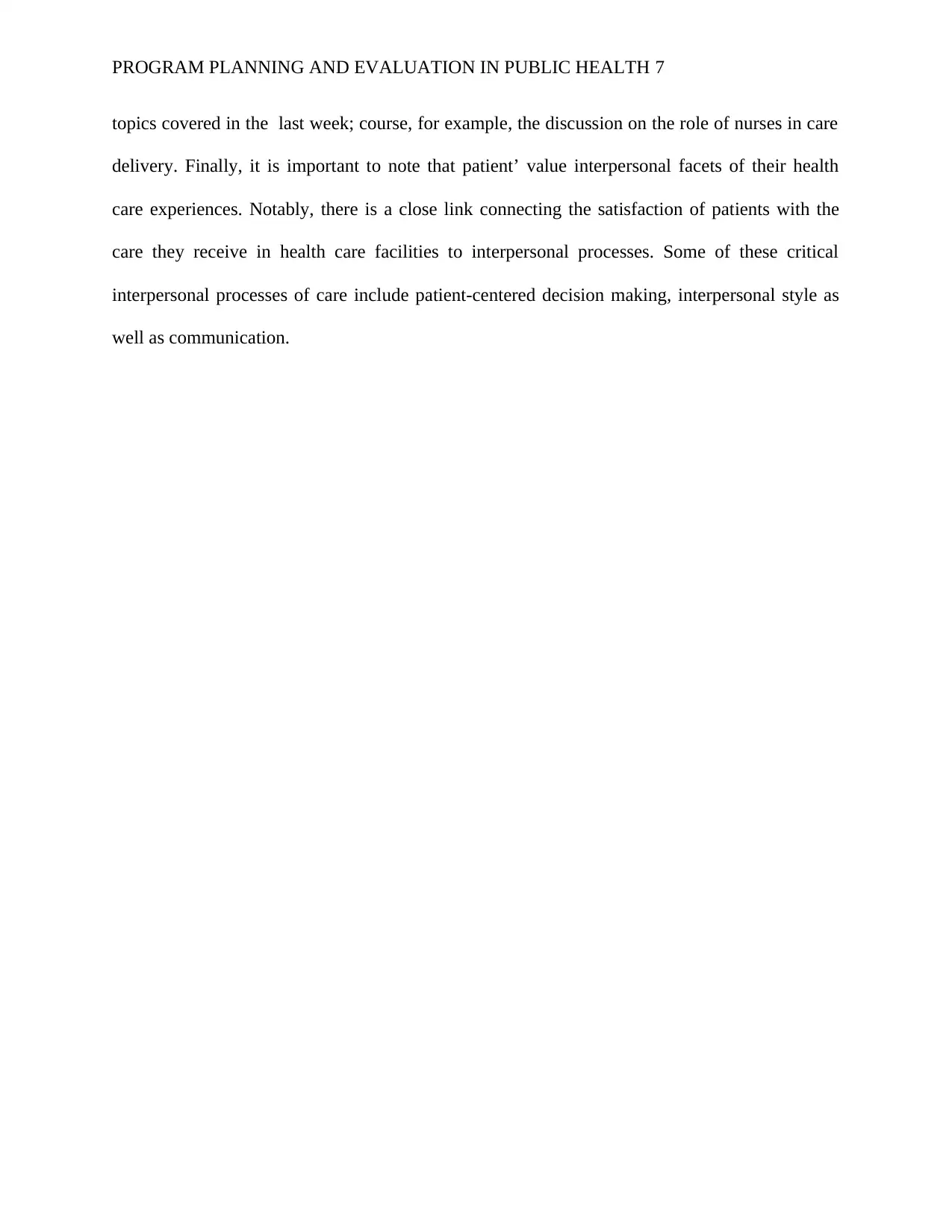
PROGRAM PLANNING AND EVALUATION IN PUBLIC HEALTH 7
topics covered in the last week; course, for example, the discussion on the role of nurses in care
delivery. Finally, it is important to note that patient’ value interpersonal facets of their health
care experiences. Notably, there is a close link connecting the satisfaction of patients with the
care they receive in health care facilities to interpersonal processes. Some of these critical
interpersonal processes of care include patient-centered decision making, interpersonal style as
well as communication.
topics covered in the last week; course, for example, the discussion on the role of nurses in care
delivery. Finally, it is important to note that patient’ value interpersonal facets of their health
care experiences. Notably, there is a close link connecting the satisfaction of patients with the
care they receive in health care facilities to interpersonal processes. Some of these critical
interpersonal processes of care include patient-centered decision making, interpersonal style as
well as communication.
Paraphrase This Document
Need a fresh take? Get an instant paraphrase of this document with our AI Paraphraser
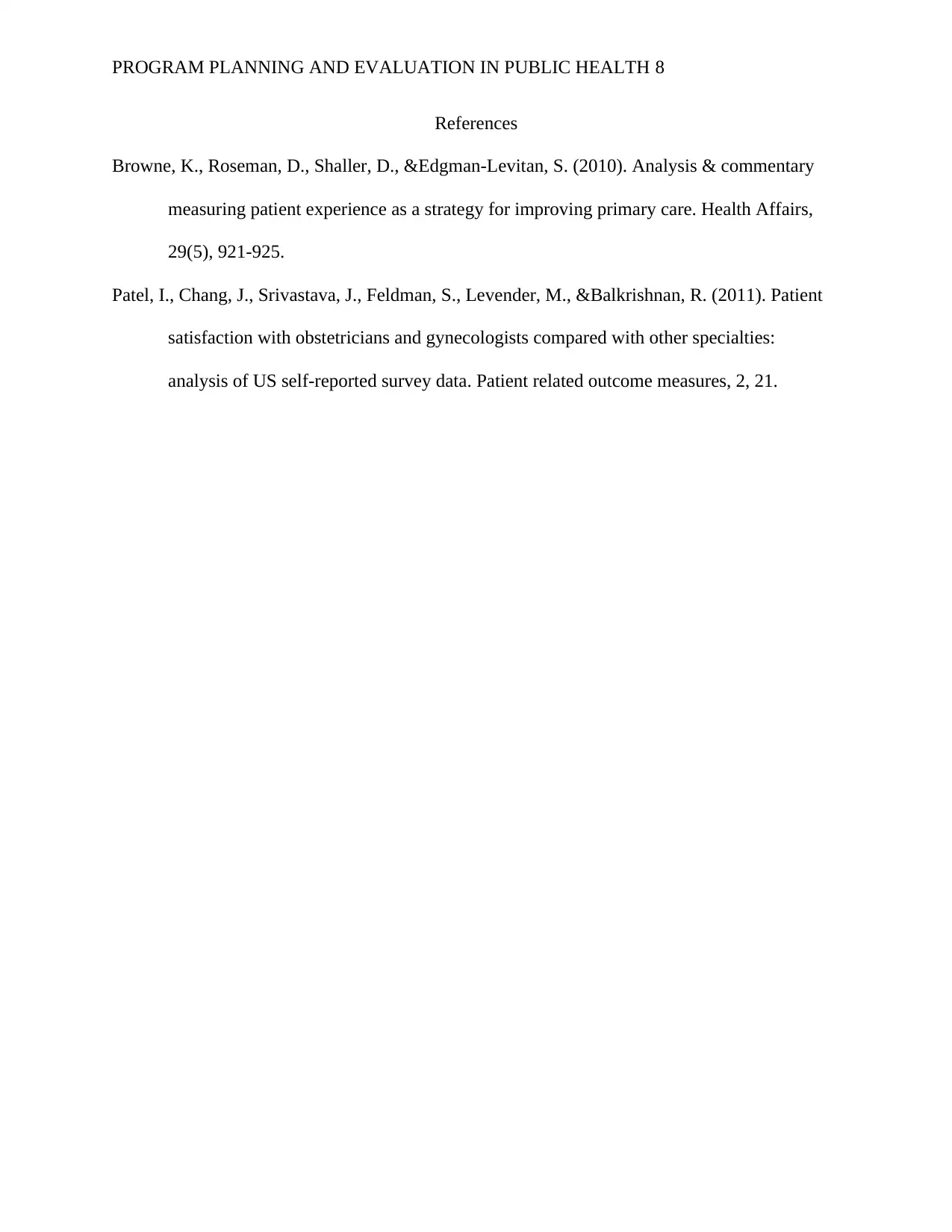
PROGRAM PLANNING AND EVALUATION IN PUBLIC HEALTH 8
References
Browne, K., Roseman, D., Shaller, D., &Edgman-Levitan, S. (2010). Analysis & commentary
measuring patient experience as a strategy for improving primary care. Health Affairs,
29(5), 921-925.
Patel, I., Chang, J., Srivastava, J., Feldman, S., Levender, M., &Balkrishnan, R. (2011). Patient
satisfaction with obstetricians and gynecologists compared with other specialties:
analysis of US self-reported survey data. Patient related outcome measures, 2, 21.
References
Browne, K., Roseman, D., Shaller, D., &Edgman-Levitan, S. (2010). Analysis & commentary
measuring patient experience as a strategy for improving primary care. Health Affairs,
29(5), 921-925.
Patel, I., Chang, J., Srivastava, J., Feldman, S., Levender, M., &Balkrishnan, R. (2011). Patient
satisfaction with obstetricians and gynecologists compared with other specialties:
analysis of US self-reported survey data. Patient related outcome measures, 2, 21.
1 out of 8
Related Documents
Your All-in-One AI-Powered Toolkit for Academic Success.
+13062052269
info@desklib.com
Available 24*7 on WhatsApp / Email
![[object Object]](/_next/static/media/star-bottom.7253800d.svg)
Unlock your academic potential
Copyright © 2020–2025 A2Z Services. All Rights Reserved. Developed and managed by ZUCOL.





